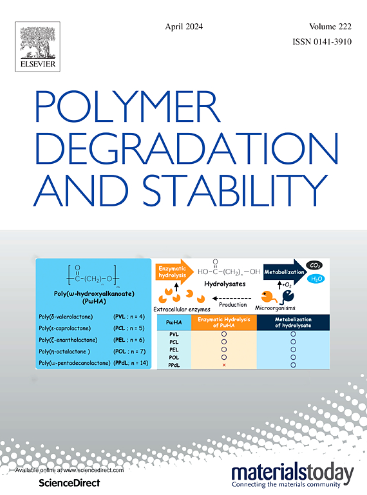Investigation on active rejuvenation mechanism of aged SBS modified bitumen: Insights from experiments and molecular dynamics
IF 6.3
2区 化学
Q1 POLYMER SCIENCE
引用次数: 0
Abstract
SBS modified bitumen (SMB) is widely used for its excellent physical and rheological properties, but it is susceptible to aging due to exposure to environmental factors such as heat, light, and oxygen. This aging process involves bitumen aging and SBS degradation, which complicates the rejuvenation of SMB. In order to explore the rejuvenation mechanism of aged SMB, particularly emphasizing the rejuvenation effects of epoxy compounds (BUDGE, TMPGE, and RDGE), a combination of molecular dynamics simulation and experiments was employed. The thermodynamic, chemical, and physical properties of rejuvenated SMB were analyzed. Results show that BUDGE and its repaired SBS exhibit excellent flexibility compared to TMPGE, improving cohesive energy density and free volume of aged bitumen, which facilitates recovery of ductility in aged SMB. Conversely, SBS repaired with RDGE increases cohesive energy density of aged SMB while reducing free volume, which enhances stiffness of bitumen. Additionally, rigid groups in RDGE inhibit mobility of both itself and the repaired SBS, leading to a reduction in the ductility of aged SMB to 10.1 cm. Besides, SBS repaired with RDGE shows strongest binding with resins and aromatics, which diminishes lubricating effect of these components on asphaltenes. This reduction in lubrication enhances aggregation of asphaltenes, ultimately raising flow resistance.
老化SBS改性沥青活性年轻化机理的研究:实验与分子动力学研究
SBS改性沥青(SMB)因其优异的物理和流变性能而被广泛应用,但由于暴露在热、光、氧等环境因素下,易发生老化。这一老化过程包括沥青老化和SBS降解,这使SMB的再生变得复杂。为了探讨老化SMB的再生机制,特别强调环氧化合物(BUDGE、TMPGE和RDGE)的再生作用,采用分子动力学模拟和实验相结合的方法。分析了活化后的SMB的热力学、化学和物理性质。结果表明,与TMPGE相比,BUDGE及其修复的SBS具有优异的柔韧性,提高了老化沥青的内聚能密度和自由体积,有利于老化沥青延性的恢复。相反,RDGE修复的SBS增加了老化SMB的内聚能密度,同时减少了自由体积,从而提高了沥青的刚度。此外,RDGE中的刚性基团抑制了自身和修复SBS的流动性,导致老化SMB的延展性降低至10.1 cm。此外,用RDGE修复的SBS与树脂和芳烃的结合最强,这削弱了这些成分对沥青质的润滑作用。这种润滑的减少增强了沥青质的聚集,最终提高了流动阻力。
本文章由计算机程序翻译,如有差异,请以英文原文为准。
求助全文
约1分钟内获得全文
求助全文
来源期刊

Polymer Degradation and Stability
化学-高分子科学
CiteScore
10.10
自引率
10.20%
发文量
325
审稿时长
23 days
期刊介绍:
Polymer Degradation and Stability deals with the degradation reactions and their control which are a major preoccupation of practitioners of the many and diverse aspects of modern polymer technology.
Deteriorative reactions occur during processing, when polymers are subjected to heat, oxygen and mechanical stress, and during the useful life of the materials when oxygen and sunlight are the most important degradative agencies. In more specialised applications, degradation may be induced by high energy radiation, ozone, atmospheric pollutants, mechanical stress, biological action, hydrolysis and many other influences. The mechanisms of these reactions and stabilisation processes must be understood if the technology and application of polymers are to continue to advance. The reporting of investigations of this kind is therefore a major function of this journal.
However there are also new developments in polymer technology in which degradation processes find positive applications. For example, photodegradable plastics are now available, the recycling of polymeric products will become increasingly important, degradation and combustion studies are involved in the definition of the fire hazards which are associated with polymeric materials and the microelectronics industry is vitally dependent upon polymer degradation in the manufacture of its circuitry. Polymer properties may also be improved by processes like curing and grafting, the chemistry of which can be closely related to that which causes physical deterioration in other circumstances.
 求助内容:
求助内容: 应助结果提醒方式:
应助结果提醒方式:


